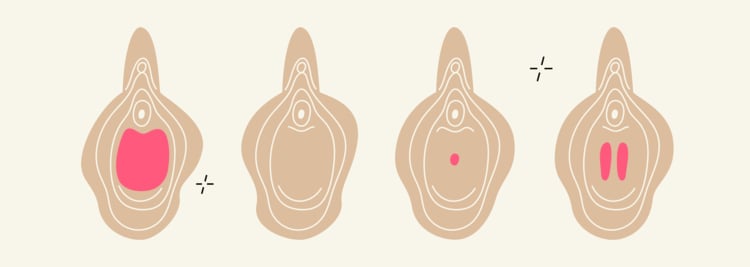A septate hymen is when the hymen partially blocks the vaginal opening with a string-like tissue connecting the top and bottom of the vagina. In this article, we’ll explain more about septate hymens, how hymen surgery such as a hymenectomy procedure can help, and the typical hymenectomy recovery time.
-
Tracking cycle
-
Getting pregnant
-
Pregnancy
-
Help Center
-
Flo for Partners
-
Anonymous Mode
-
Flo app reviews
-
Flo Premium New
-
Secret Chats New
-
Symptom Checker New
-
Your cycle
-
Health 360°
-
Getting pregnant
-
Pregnancy
-
Being a mom
-
LGBTQ+
-
Quizzes
-
Ovulation calculator
-
hCG calculator
-
Pregnancy test calculator
-
Menstrual cycle calculator
-
Period calculator
-
Implantation calculator
-
Pregnancy weeks to months calculator
-
Pregnancy due date calculator
-
IVF and FET due date calculator
-
Due date calculator by ultrasound
-
Medical Affairs
-
Science & Research
-
Pass It On Project New
-
Privacy Portal
-
Press Center
-
Flo Accuracy
-
Careers
-
Contact Us
Septate Hymen: What It Is and How a Hymenectomy Helps


Every piece of content at Flo Health adheres to the highest editorial standards for language, style, and medical accuracy. To learn what we do to deliver the best health and lifestyle insights to you, check out our content review principles.
What is a septate hymen?
The hymen is a thin membrane-like sheath that covers the opening of the vagina. Babies have a thick hymen because of how the vaginal canal develops in utero. Over time, the hymen will become thinner and eventually break, possibly from exercise, inserting a tampon, or through sexual intercourse.
Hymens come in all shapes and sizes. Typically, the hymen is a small doughnut-shaped ring of tissue that encircles the opening of the vagina. It may also look like a crescent or half-moon shape toward the bottom end of the vaginal opening.
A septate hymen is when the hymen encircles the vaginal opening and has an additional string of tissue that connects the top and bottom ends of the vagina. A septate hymen makes it look like there are two vaginal openings, but there is only one that is partially obstructed down the middle.
Septate hymens affect about 1 in every 1,000 girls. Most people don’t realize that they have a septate hymen until they begin menstruating or try to have sex. With a septate hymen, it may be difficult to insert or remove a tampon because the vaginal opening is partially blocked. It’s also possible to experience pain or bleeding during vaginal intercourse as a result of a hymenal tear.
A septate hymen is one of a few types of abnormally shaped hymens. Others include:
- A cribriform hymen, which is perforated with many small holes
- An imperforate hymen, which covers the entire opening of the vagina
- A microperforate hymen, which covers the opening of the vagina but still has a small hole in it
There’s no known cause for an abnormally shaped hymen, and these anomalies are congenital, meaning they’re present at birth. Doctors may recommend minor surgery to correct an abnormal hymen either at birth or as soon as it causes issues. Any problems with an abnormal hymen are likely to come up during puberty or as the person becomes sexually active.
To determine if your hymen is causing issues with using tampons or having sex, your doctor will perform a vaginal exam. For a septate hymen, the way to correct the abnormality is with a hymenectomy procedure.
Hymenectomy — septate hymen surgery

Take a quiz
Find out what you can do with our Health Assistant
If the septate hymen tissue doesn’t tear naturally or through intercourse, the doctor might recommend a hymenectomy. A hymenectomy is a simple surgical procedure to remove the excess hymenal tissue from the vaginal opening.
Doctors can typically perform the procedure in their office or outpatient clinic with a localized anesthetic. They’ll numb the area and use a scalpel or surgical scissors to cut the connecting tissue and then use stitches to close the incision points. Often, the doctor will use sutures that dissolve naturally, so you don’t have to go back to the clinic to have them removed.
The most common reasons for a hymenectomy include:
- Improving the flow of your blood, secretions, and tissue out of the vagina during menstruation
- Making it easier to use a tampon, especially removing one that has expanded with blood
- Reducing pain or discomfort associated with vaginal penetration
- Reducing the risk of developing bladder infections, which can be associated with an unbroken hymen
For people with an imperforate hymen (one that completely covers the vaginal opening), a hymenectomy can reduce the risk of developing serious health complications such as infections or abdominal pain from blocked menstrual flow. Most patients who have septate hymen surgery are starting puberty, which is when their hymenal tissues have become “estrogenized,” which makes them thicker and block more of the vaginal opening.
Although a hymenectomy is a minor surgery, there can still be some associated risks. These risks include:
- Itching or irritation as the wound heals and sutures dissolve
- Potential for infection after surgery and during the healing process
- Increased risk of bleeding after surgery
- Inflammation or swelling around the vulva or in the vagina
- Pain or discomfort that lasts longer than typical hymenectomy recovery time
- Possible trauma to the urethra, which can inhibit your ability to urinate freely
- Scarring or the build-up of scar tissue, which can cause increased pain
Hymenectomy recovery
After a septate hymen surgery, it can take several weeks before you can resume your regular routine. Your doctor will tell you what to expect with a hymenectomy recovery and how you can help with the healing process.
Following a septate hymen removal procedure, your doctor may recommend:
- Applying cream or ointment on the stitches to help heal the wounds
- Taking over-the-counter or prescription pain medication to help alleviate pain or discomfort as you recover from the septate hymen surgery. Be sure to ask your doctor whether there are any medications you shouldn’t take, such as aspirin tablets.
- Refraining from having sex until the wounds are fully healed. Your doctor might recommend a follow-up appointment a few weeks after surgery to check on your recovery progress.
- Avoiding using tampons during your period
- Avoiding excessively cleaning your genitals, especially douching. You might want to try a warm sitz bath, which is a specially designed small tub that you can sit on (similar in shape to a toilet). Be sure to use warm water, cooler than the temperature of bathwater.
- Using an ice pack to reduce swelling around your genitals. Wrap the ice pack in a cloth and put it over your pants or underwear instead of applying the pack directly to your skin.
- Avoiding lifting anything heavier than five pounds to reduce the risk of breaking the sutures
Follow any other precautions or instructions that your doctor gives you. If you have any questions or concerns about your hymenectomy recovery, call your doctor.
The summary
Hymens come in all shapes and sizes. Many people never even notice their hymen unless it prevents the flow of menstrual fluids, limits their ability to use tampons, or causes painful sex.
If you have a hymenal anomaly – for example, a septate hymen – it might resolve on its own when it breaks during sex or using a tampon. You can also have minor surgery to correct it if necessary. Talk to your doctor if you have any questions about your genitals.


Hey, I'm Anique
I started using Flo app to track my period and ovulation because we wanted to have a baby.


The Flo app helped me learn about my body and spot ovulation signs during our conception journey.


I vividly
remember the day
that we switched
Flo into
Pregnancy Mode — it was
such a special
moment.
Real stories, real results
Learn how the Flo app became an amazing cheerleader for us on our conception journey.




